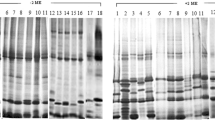Summary
Gel electrophoretic investigations were made on the seed albumins of several members of the family Papilionaceae. Relationships were found with taxa of a lower order i.e. between mutants, varieties and subspecies. More distantly related ones, for example species of the same genus or species of different genera, did not show similarities. Thus, it was concluded that the albumin banding pattern is only suitable for studying phylogenetic and taxonomic problems if the material under investigation is not too distantly related.
Similar content being viewed by others
Literature
Adriaanse, A.; Klop, W.; Robbers, J.E. (1969): Characterization of Phaseolus vulgaris cultivars by their electrophoretic pattern J. Sci. Food Agric. 20, 647–650
Cherry, J.P.; Katterman, F.R.H.; Endrizzi, J.E. (1971): Comparative studies of seed proteins of species of Gossypium by gel electrophoresis. Evolution 24, 431–447
Danielsson, C.E. (1947): Seed globulins of the Gramineae and Leguminosae. Biochem. J. 44, 387–400
Dass, H.C. (1972): Analysis of species relationships in Avena by thinlayer chromatography and disc electrophoresis. Canad. J. Genet. Cytol. 14, 305–316
Davis, P.H. (1970): Flora of Turkey, Vol. III. Edingburgh: University Press
Fox, D.J.; Thurman, D.A.; Boulter, D. (1964): Studies on the proteins of seeds of the Leguminosae I. Albumins. Phytochemistry 3, 417–419
Frielinghaus, G. (1976): Möglichkeiten und Grenzen der Chemotaxonomie. Wiss. Arbeit im Rahmen der ersten Staatsprüfung für das Lehramt an Gymnasien, Univ. Bonn
Govorov, L. (1937): Erbsen, Flora of Cultivated Plants 4, 231–336
Harborne, J.B.; Boulter, D.; Turner, B.L. (1971): Chemotaxonomy of the Leguminosae. London, New York: Acad. Press
Ladizinsky, G. (1975): Seed protein electrophoresis of the wild and cultivated species of selection Faba or Vicia. Euphytica 24, 785–788
Ladizinsky, G.; Hymowitz, T. (1979): Seed protein electrophoresis in taxonomic and evolutionary studies. Theor. Appl. Genet. 54, 145–151
Lamprecht, H. (1966): Die Entstehung der Arten und höheren Kategorien. Wien, New York: Springer
Larsen, A.L. (1967): Electrophoretic differences in seed proteins among varieties of soybean, Glycine max (L.) Merill. Crop. Sci. 7, 311–313
Lehmann, Ch.O. (1954): Das morphologische System der Saaterbsen (Pisum sativum L. sens lat. Gov. ssp. sativum). Züchter 24, 316–337
McDaniel, R.G. (1970): Electrophoretic characterization of proteins in Hordeum. J. Hered. 61, 243–247
Przybylska, J.; Blixt, St.; Hurich, J.; Zimniak-Przybylska, Z. (1977): Comparative studies of seed proteins in genus Pisum. Genet. Polon. 18, 28–37
Smith, P.M. (1976): The Chemotaxonomy of Plants. Contemporary Botany (Eds. Barrington, E.J.W., Willies, A.J.) London: Edward Arnold
Author information
Authors and Affiliations
Additional information
Communicated by O.E. Nelson
Rights and permissions
About this article
Cite this article
Wolff, G. Investigations on the relations within the family papilionaceae on the basis of electrophoretic banding patterns. Theoret. Appl. Genetics 57, 225–232 (1980). https://doi.org/10.1007/BF00264675
Received:
Accepted:
Issue Date:
DOI: https://doi.org/10.1007/BF00264675




